In the rapidly evolving landscape of healthcare, content marketing has emerged as a vital tool for healthcare providers and organizations to connect, educate, and engage with their audience. In this article, we delve into the strategies that will help you supercharge your healthcare content marketing efforts in 2024.
What role does content marketing play in healthcare?
Content marketing in healthcare is a proactive approach that enables healthcare providers to leverage digital channels to reach both local and global audiences while distinguishing themselves from competitors. It involves creating and sharing informative, engaging, and multimedia types of content, such as articles, videos, infographics, and podcasts, that address the needs and interests of potential patients and healthcare organizations.
Healthcare brands can establish themselves as trusted authorities in their respective fields by producing valuable, relevant, high-quality content for their audience. This, in turn, helps in capturing search traffic as people seek out health-related information online. Whether it’s educational blog posts about managing chronic conditions, video content explaining medical procedures, or infographics on wellness tips, content marketing bridges healthcare providers and their target audience.
In essence, healthcare content marketing empowers organizations to educate and engage their audience, build credibility, and foster lasting relationships in an increasingly digital and competitive healthcare landscape.
Why is content marketing important in healthcare?
Content marketing efforts hold paramount importance in the healthcare industry for several compelling reasons. First and foremost, the ubiquity of Google search as a primary source of medical information means that healthcare organizations have an unparalleled opportunity to provide valuable and actionable advice to a wider audience. With over a billion healthcare-related search terms daily, a content marketing strategy allows them to tap into this demand.
Furthermore, healthcare content marketing has various key benefits. It builds trust by showcasing the expertise and people behind the organization, reducing current patient anxiety by providing clear information and answers to questions, and capturing local search traffic for long-term lead generation. By offering informative and engaging content pieces of content, healthcare brands differentiate themselves from competitors and establish a loyal audience.
The high success rate of content marketing in healthcare, as evidenced by 99% of surveyed companies generating positive results, highlights its effectiveness. With a significant percentage reporting moderate to very successful outcomes, it’s clear that content marketing is a powerful tool for healthcare organizations to connect with their audience, build credibility, and drive lasting patient engagement.
Review this infographic for additional details about the importance of content marketing in healthcare:
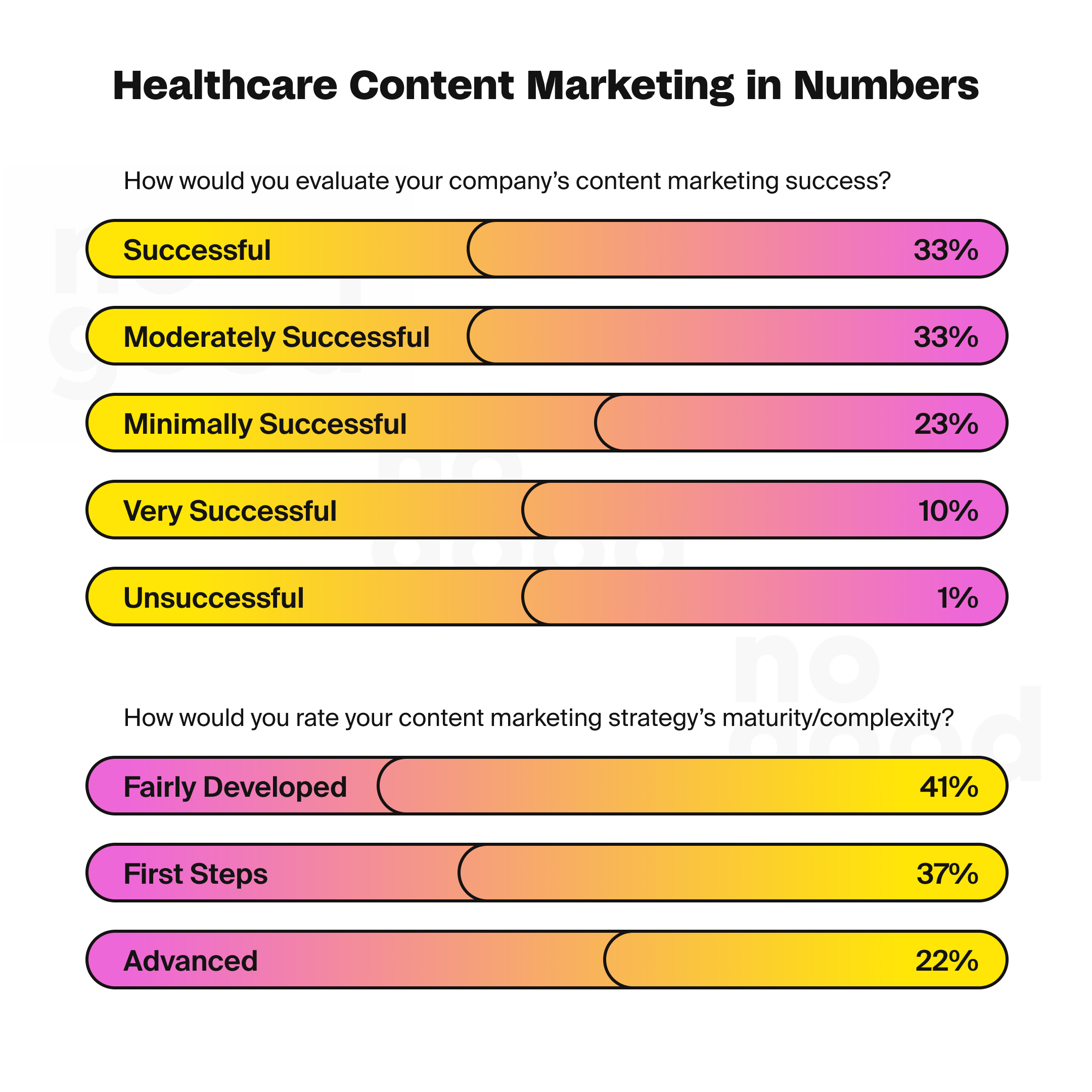
Strategies to accelerate your healthcare content marketing in 2024
Strategy 1: Assess the current situation in your healthcare company
The first step in creating a comprehensive healthcare content marketing strategy is to assess your current situation. This initial phase lays the foundation for your strategy by providing essential insights and context. Let’s delve into this crucial step and expand upon it:
Assess the situation of your company
- Company goals: Begin by understanding the broader goals of your healthcare organization. What are the mission, vision, and long-term objectives? How does content marketing fit into these goals?
- Challenges and objectives: Identify the specific challenges you aim to address through your content marketing efforts. What are the key objectives you intend to achieve? For example, is it to enhance patient engagement, establish thought leadership, or drive lead generation?
- Budget allocation: Determine how much your healthcare marketing budget will be allocated to content. This allocation will shape the scope and scale of your content initiatives.
- Expected deliverables and cadence: Define what you plan to deliver through your content marketing strategy. Will it be blog posts, videos, infographics, or a combination? Establish a cadence for content creation and publication.
- Stakeholder involvement: Identify all stakeholders involved or impacted by the content strategy. This includes the content development team and individuals in various roles who may have insights or dependencies on the content.
Be aligned on the results of the overall strategy
While it can be challenging to pinpoint the hard ROI of content marketing in isolation, it’s crucial to clarify the overarching objectives of your content initiatives. Ask questions such as:
- What are we aiming to accomplish with our healthcare content marketing efforts?
- Are we primarily focused on improving brand awareness, driving lead generation, increasing customer retention, or a combination of these goals?
Segment, define, and create personas for your audience
- Buyer’s journey: Map out the buyer’s journey within your healthcare context. Identify a prospective patient or customer’s stages, from awareness to decision-making.
- Buyer personas: Create detailed buyer personas to segment your audience effectively. Consider factors such as demographics, roles in the purchasing process (e.g., economic, technical, end-user), and specific use cases.
- Influencers: Recognize the influencers within your healthcare ecosystem. This could include Key Opinion Leaders (KOLs), financial analysts, regulatory bodies like the FDA, and other healthcare systems.
- Audience needs and pain points: Understand your audience’s needs, challenges, and pain points. What are their priorities when seeking healthcare information or services?
- Unique value proposition: Define the unique value proposition your healthcare organization provides. How does it address the specific needs of your audience?
By diligently addressing these foundational aspects in the planning phase of your healthcare content marketing strategy, you’ll be better equipped to create content that resonates with your audience, aligns with your organization’s goals, and ultimately drives meaningful results in the healthcare sector.
Strategy 2: Gain content marketing insights from your patients
The initial step entails connecting with your audience and acquiring insights into their inquiries, which you can incorporate into your content. This action lays the groundwork for formulating a customer-centric content strategy.
There are various approaches that healthcare organizations can employ to accomplish this, for example:
- Encourage your community to submit questions directly. You can set up a dedicated email address, utilize a website submission form, or engage through direct messages on social media platforms. It’s crucial to emphasize that these platforms should not be used for sharing personal health information.
Internal sources can also serve as a wellspring of content ideas. This includes consulting your clinical teams about their passion projects and aligning them with your audience’s needs. Collaboration with customer-facing teams, such as customer support, can facilitate the analysis of patient and prospect requests and inquiries. Additionally, getting content ideas from other successful healthcare marketing campaigns can be valuable.
Moreover, conducting traditional audience research is vital for effective content marketing. Rushing into content creation without understanding your content marketing audience often yields subpar results, if any. Here’s how to do this:
- Listen to your audience. Schedule meetings with customers and conduct interviews to comprehend your audience’s challenges, explaining them in plain language if possible. Learn the terminology they use to discuss their industry and incorporate it into your content. Depending on your target audience (e.g., healthcare solution purchasers), the language can vary significantly—relying solely on search results may provide limited insights.
When engaging with clients and prospects, gather the following information to ensure you possess sufficient knowledge for crafting resonant content:
What are their preferred communication methods, channels, and content formats?
This information will guide your choice of platforms for disseminating content and the most effective media types to employ. Pay attention to the communication style they employ. Are they formal or more casual when communicating with you? This insight will help you determine the appropriate tone for addressing this specific audience.
Determining healthcare patients’ preferred communication channels is a critical step in effectively reaching and engaging with your target audience. To address the question of how to identify these preferred channels, we can draw insights from the following considerations:
- Audience-centric approach: Start by putting your healthcare patients at the center of your communication strategy. Understand their preferences, behaviors, and habits when it comes to seeking healthcare information.
- Analyze information consumption habits: Investigate how your audience consumes healthcare-related information. Are they more inclined to seek information in person, online, through traditional media like billboards, or a combination of these? By understanding their habits, you can tailor your approach accordingly.
- Online presence: In today’s digital age, online channels often play a pivotal role. Explore which online platforms your healthcare patients frequent. Do they engage with health-related content on social media platforms, read healthcare blogs, or participate in online health communities?
- Social media insights: Dive deeper into social media usage. Identify the specific social platforms your audience prefers. For instance, younger demographics might be active on platforms like Instagram or TikTok, while older individuals may prefer Facebook or LinkedIn. Knowing where your audience spends their online time can guide your content distribution.
- Publications and news sources: Examine the publications, news outlets, or magazines your target audience trusts and reads regularly. This could include medical journals, local newspapers, or healthcare-focused magazines. Consider partnerships or advertising opportunities in these publications to reach your audience.
- Feedback and surveys: Actively seek feedback from your patients through surveys or direct conversations. Ask them about their preferred communication channels and what type of content they find most valuable. This firsthand information can be invaluable for refining your strategy.
- Demographic and psychographic data: Leverage demographic and psychographic data to gain insights into your patient population. Age, gender, interests, and lifestyle can influence communication preferences. Tailor your approach based on these insights.
- Content testing: Experiment with different communication channels and content formats. Monitor the performance of your content across various platforms. Analyze metrics such as engagement, click-through rates, and conversions to gauge which channels are most effective in reaching and resonating with your audience.
- Adapt and evolve: Keep in mind that preferences and behaviors may evolve over time. Stay attuned to changing trends and adapt your communication strategy accordingly. Regularly revisit your patient personas to ensure they remain accurate and up to date.
- Multi-channel strategy: Consider adopting a multi-channel approach to reach a broader spectrum of patients. Combining online and offline channels can provide comprehensive coverage and cater to diverse preferences.
By thoroughly researching and understanding your healthcare patients’ preferred communication channels, you can create a tailored communication strategy that effectively delivers valuable healthcare information, fosters engagement, and enhances the overall patient experience. This approach builds trust and ensures that patients receive the information they need through their preferred means of communication.
Strategy 3: Find out which topics are of interest to your audience
Once you’ve grasped your audience and the community you serve, it’s time to unearth the specific subjects to incorporate into your content strategy.
Establish your subject matter authority
Subject matter authority revolves around enhancing your proficiency in a specific subject area within a particular niche. By producing substantial volumes of top-tier content on a particular topic, you can cultivate credibility with your audience and convey favorable signals to search engines.
For instance, consider a scenario where you’re developing content for a mental health clinic, and you’ve noticed a rising demand and curiosity in anxiety treatment services.
To establish subject matter authority, it’s crucial to craft high-quality content addressing various subtopics and queries linked to anxiety. Here’s how to do this:
- Irrespective of the subject, there are at least 25 approaches to tackle it. Once you’ve brainstormed the subject concerning your target personas’ needs, you can leverage keyword research to refine your ideas and pinpoint your topic focus.
Keyword research stage
* Although you can use a variety of keyword research tools, such as Frase or SEMrush, we’ve used Ahrefs for this example.
Regarding your keyword research, it’s important to note that developing a comprehensive healthcare SEO strategy in conjunction with your content marketing efforts is essential for a successful healthcare content marketing strategy.
Step 1
First, navigate to your keyword research tool, enter the ‘anxiety’ subject, and select your preferred location (country, region, or city).
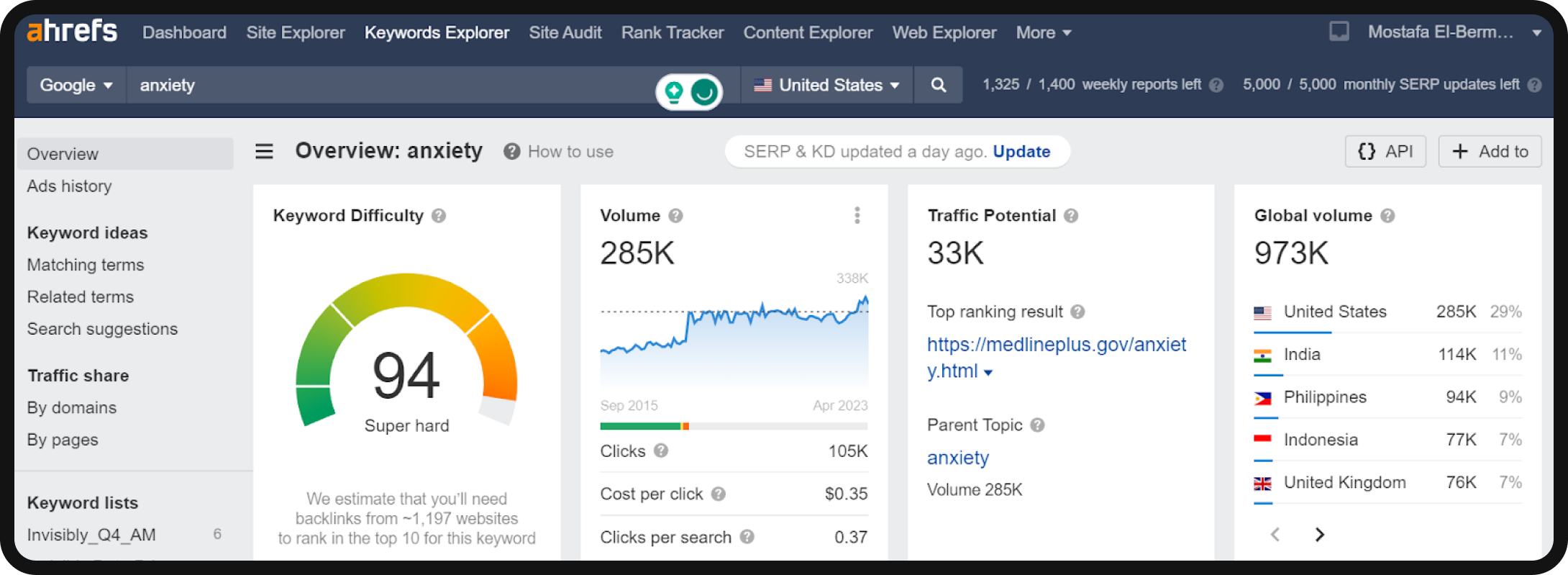
Step 2
Click’ Matching or Related terms’ and generate an array of interconnected subtopics. You can explore different perspectives, such as questions.
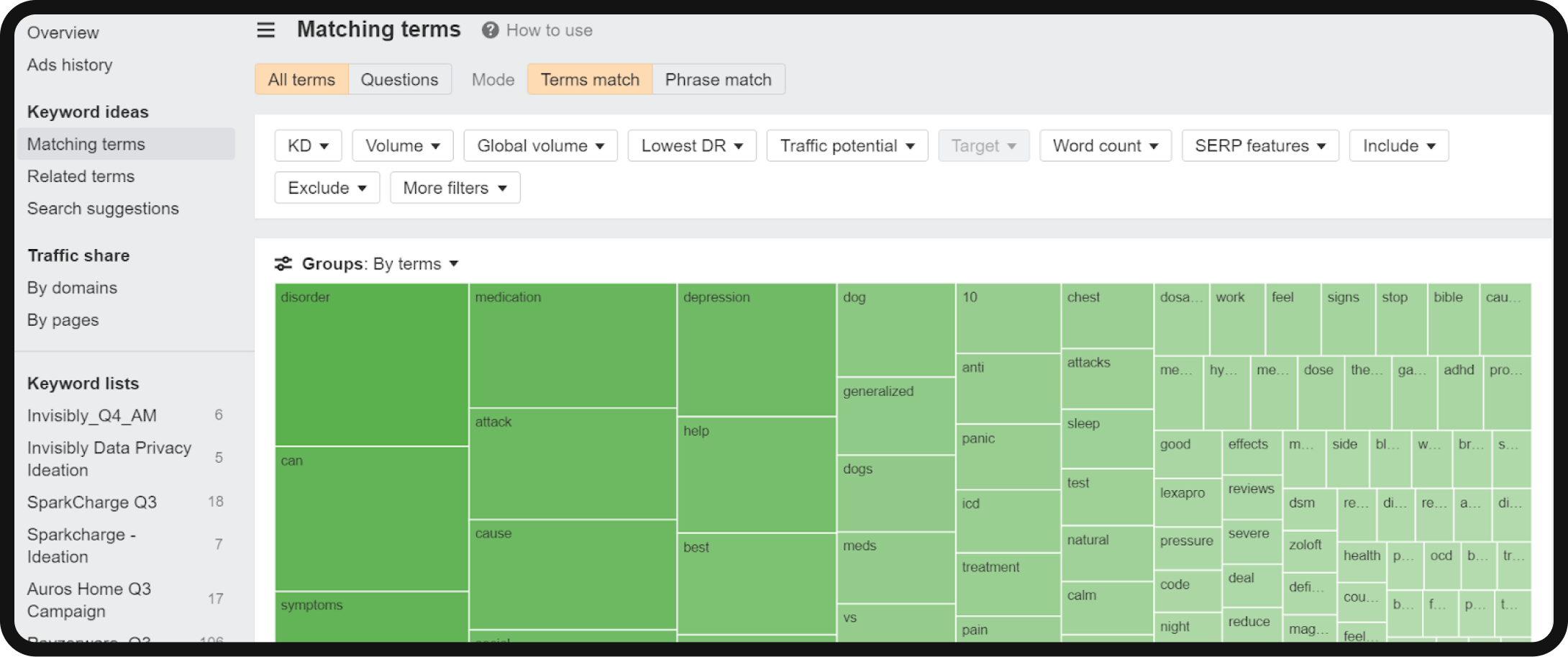
You’ll also come across various popular headlines and queries that web users pose regarding each subtopic.
Step 3
From here, you can promptly compile a list of topics to include in your topic cluster. For example, your clinic might decide to concentrate on the following overarching content concepts:
- Anxiety signs and symptoms
- Anxiety disorders
- Obsessive-compulsive disorder
- Selective mutism
- Social anxiety disorder
Keep in mind that some of these subtopics might eventually evolve into independent content pillars or cluster focal points. Every topic in your content plan will be associated with a set of related keywords. Conducting keyword research for each piece of content will enable you to tailor your content to the preferences of online searchers and gauge potential gains.
Suppose we’ve opted for the ‘social anxiety disorder’ topic from the abovementioned list. Head over to the ‘Keyword Explorer tool’ and input it.
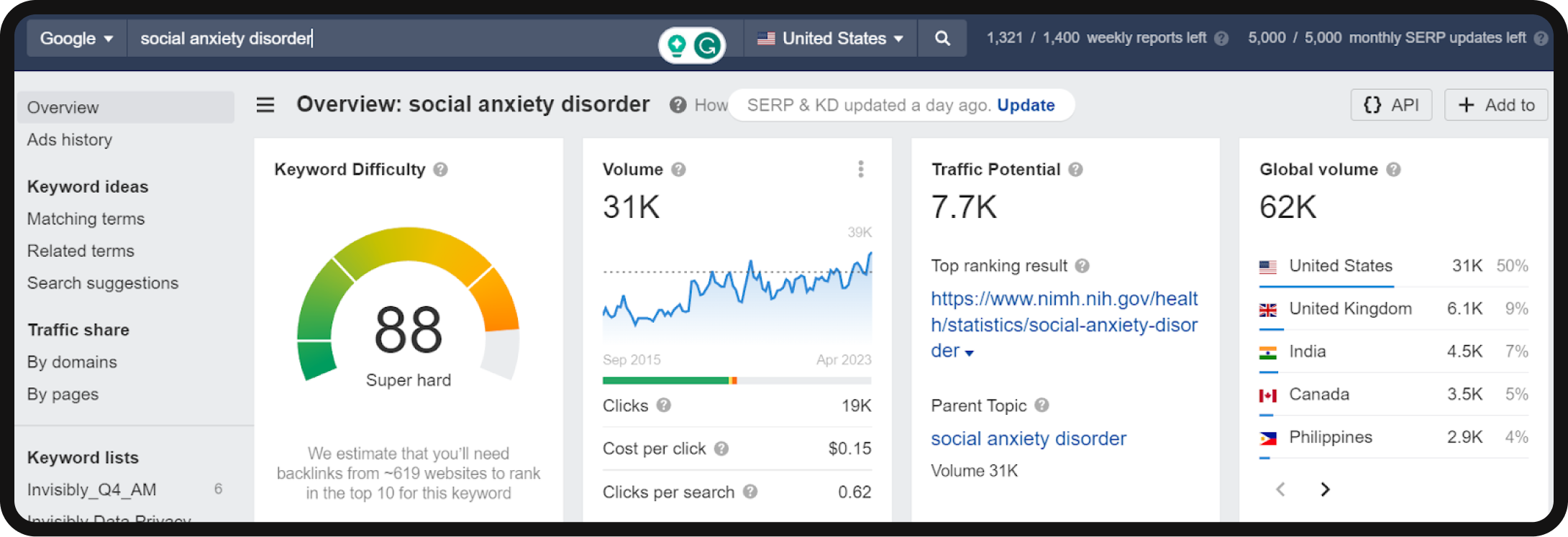
You’ll be presented with a list of correlated keywords, along with details on search volume, search intent, and keyword difficulty. Let’s also assume that you believe this keyword is worth pursuing, a decision that hinges on your estimation of the results it can yield and the resources required for ranking.
The keywords for your content might encompass:
- Social anxiety symptoms
- How to overcome social anxiety
- What causes social anxiety
- Difference between anxiety and panic attack
Step 4
Your next step is to contemplate semantically related keywords. These can enhance the context and depth of your content. Again, here, you can use either Frase, SEMrush, or Ahrefs. We’ve used Frase to illustrate our point.
In Frase, navigate to the new document section and input the ‘social anxiety disorder’ keyword. Click ‘create document’ to generate a list of semantically linked keywords and view additional details like optimal content length and target readability.
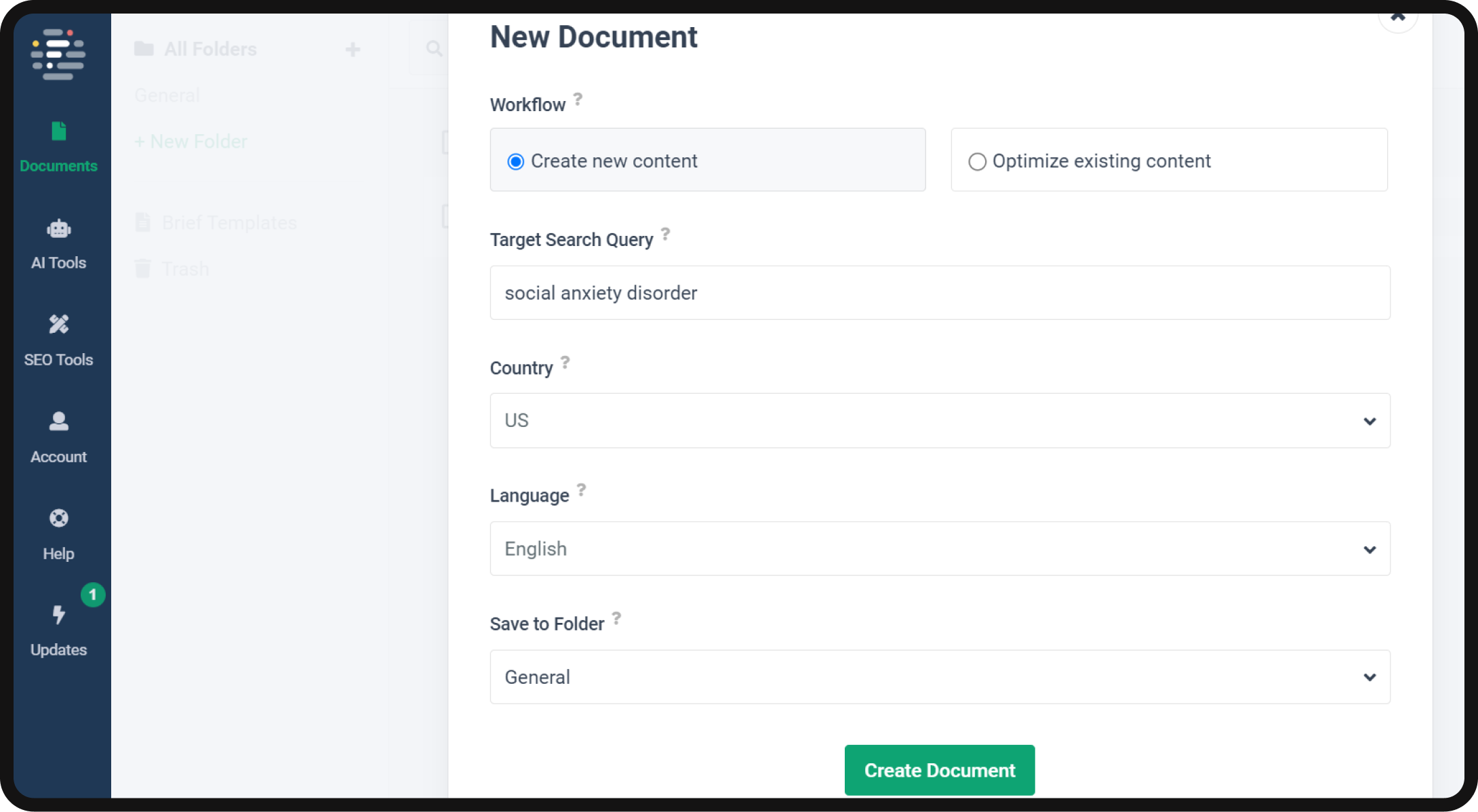
In the ‘Research’ section, you’ll be able to see what word count you should target and the number of headers, links, and images.
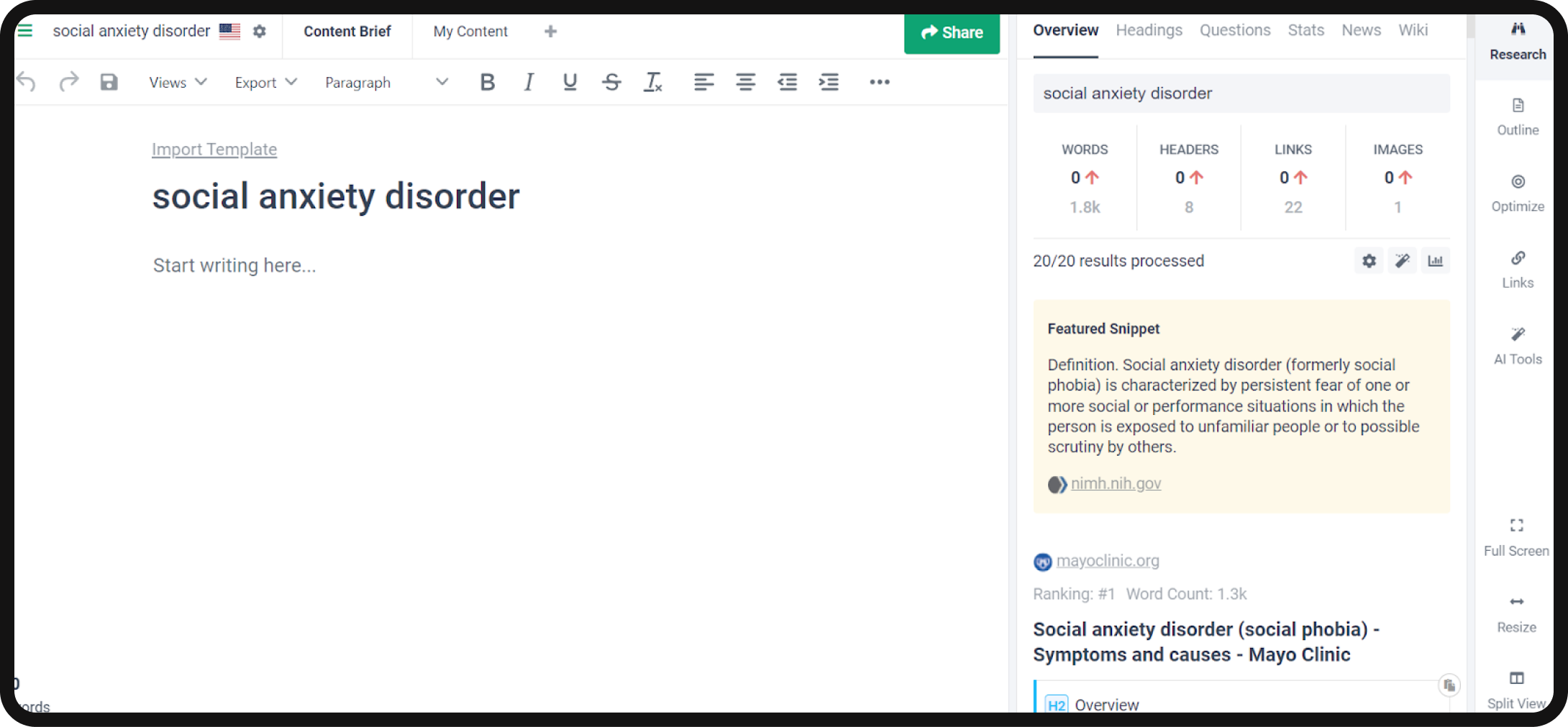
To consider which semantically related keywords you should include in your content, you can head over to the ‘Optimize’ section in Frase. You’ll be able to filter by top topics, long tail, clusters, titles, headers, and blacklist semantically related keywords.
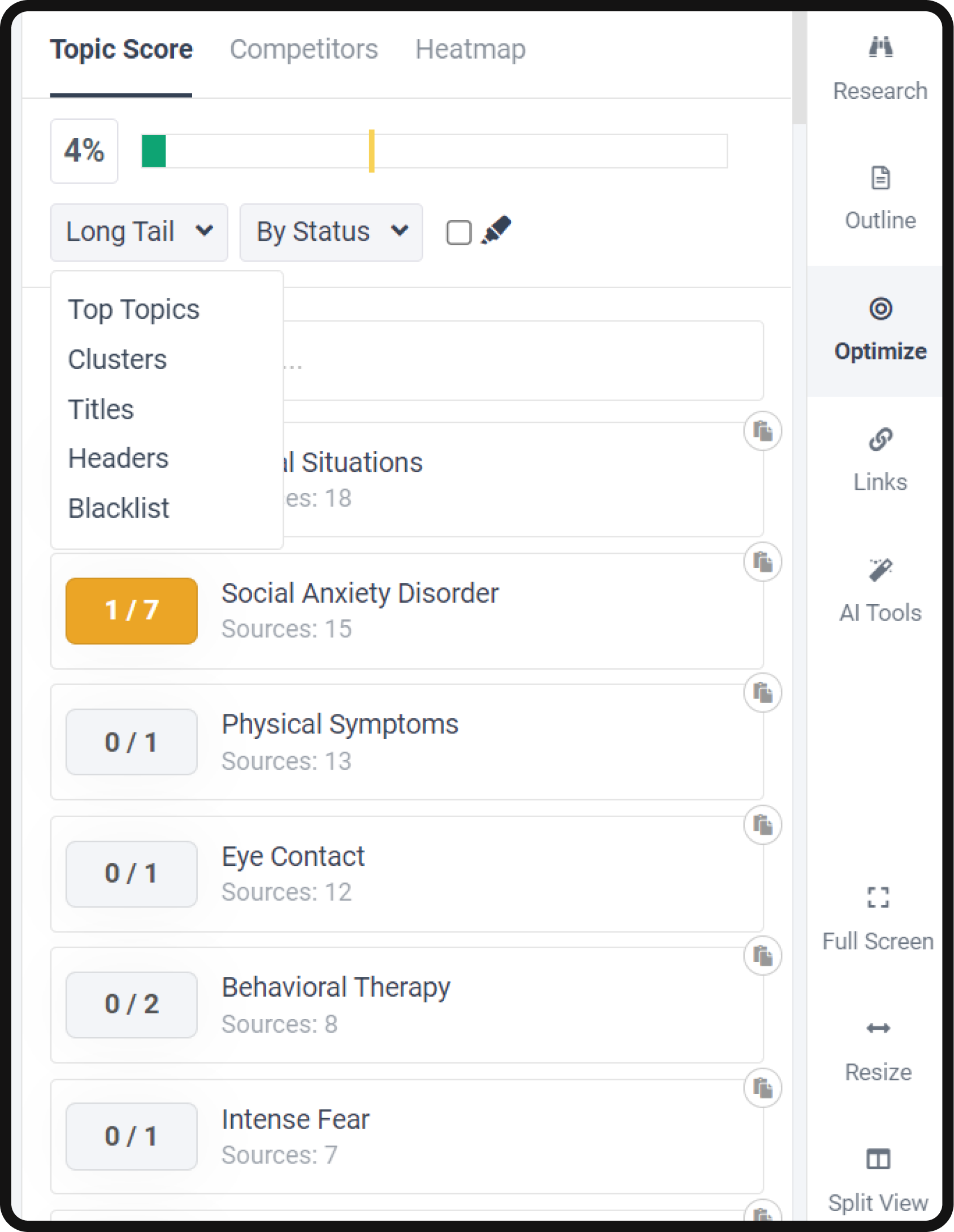
One of our favorite features within Frase to consider semantically related keywords is the ‘Heatmap’ setting. Here, you’ll be able to see which semantically related keywords your competitors are using the most. Again, you can filter by long tail and top topics.
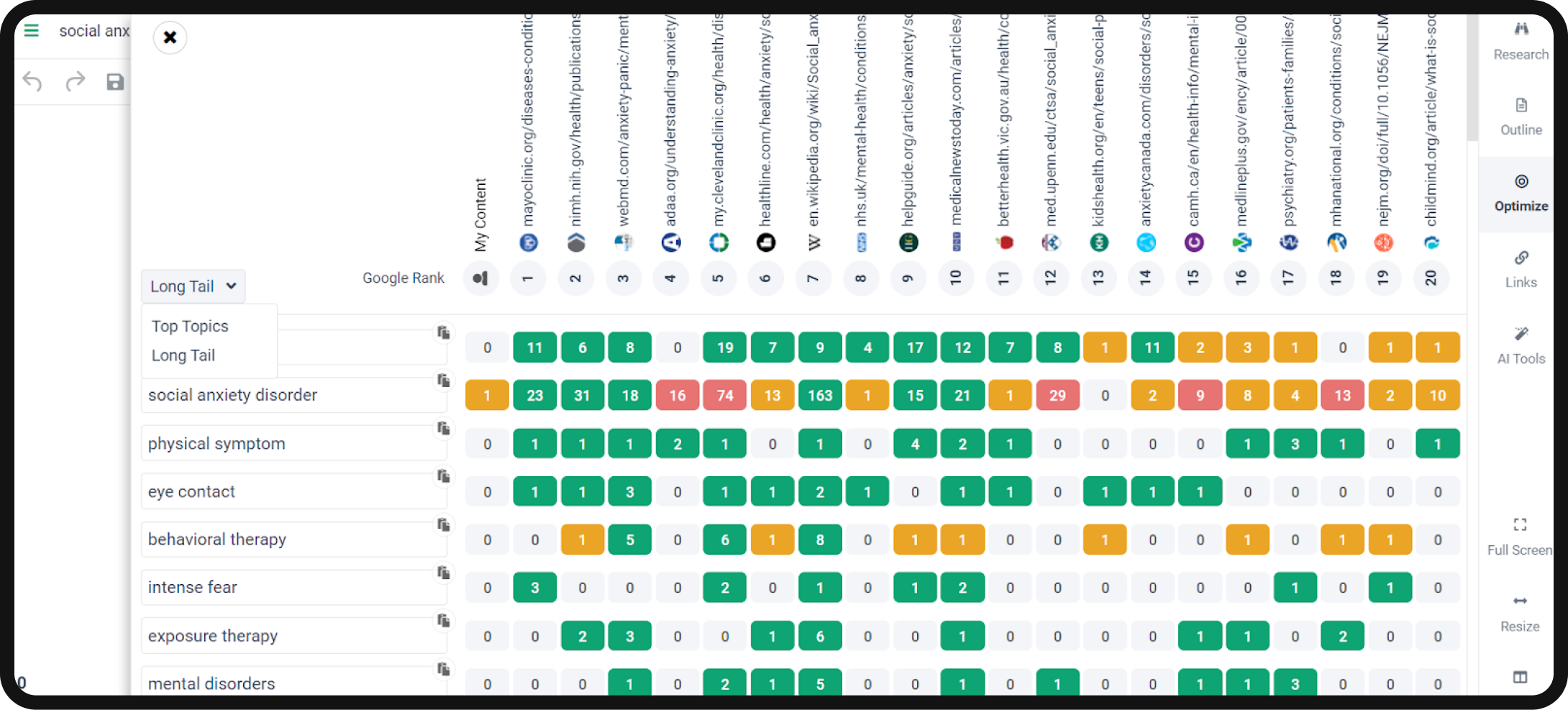
Step 5
Lastly, any quest for content ideas would be incomplete without competitive research, and the healthcare sector is no exception.
Your competitive content analysis should encompass several key steps:
- Compilation of a list of direct and indirect competitors (Ahrefs and SEMrush are both great tools to use for this).
- Assessment of their overall content strategy: content formats they employ, the content categories they focus on, and the channels they utilize for content promotion. Carefully scrutinize their websites and social media platforms.
- Evaluation of their current SEO strategies: e.g., the informational and transactional keywords they rank for and identification of their top-performing pages. Leverage the Organic Research tool.
- Keyword gap analysis: uncover keywords they already rank for and identify potential content opportunities. Utilize the Keyword Gap tool.
- Search intent analysis: analyze the top-ranking pages for each keyword. Employ AI tools like ContentShake to incorporate these insights into your content creation process seamlessly.
Explore social media options
Your analysis of topics and trends should not be confined to the workflow outlined above. In fact, it’s crucial to explore various available platforms to gain a deeper insight into your audience’s needs and preferences. Here’s how you can do this:
- Browse forums and check various social media platforms to see if content related to pertinent health issues is being generated and shared. Numerous channels, profiles, or groups openly share experiences, challenges, and more, which can spark engagement and discussions and, in turn, offer relevant topics to address in your content.
You can also participate in industry events to stay updated on trends and capitalize on recent news stories to craft valuable content on trending topics. This is commonly known as “newsjacking.”
For instance, let’s say your mental health clinic wants to create timely content about coping with anxiety, and you’re looking for inspiration beyond your industry. Consider the approach taken by the wellness brand Headspace.
Headspace regularly creates blog posts and social media content that addresses anxiety management techniques and mindfulness practices. Their website has a dedicated section that provides resources for dealing with anxiety, including articles, guided meditations, and expert advice.
Their content often aligns with trending topics and events, such as providing tips for managing anxiety during the holiday season or during periods of high workplace stress. This strategy has helped them stay relevant and engage with a broader audience.
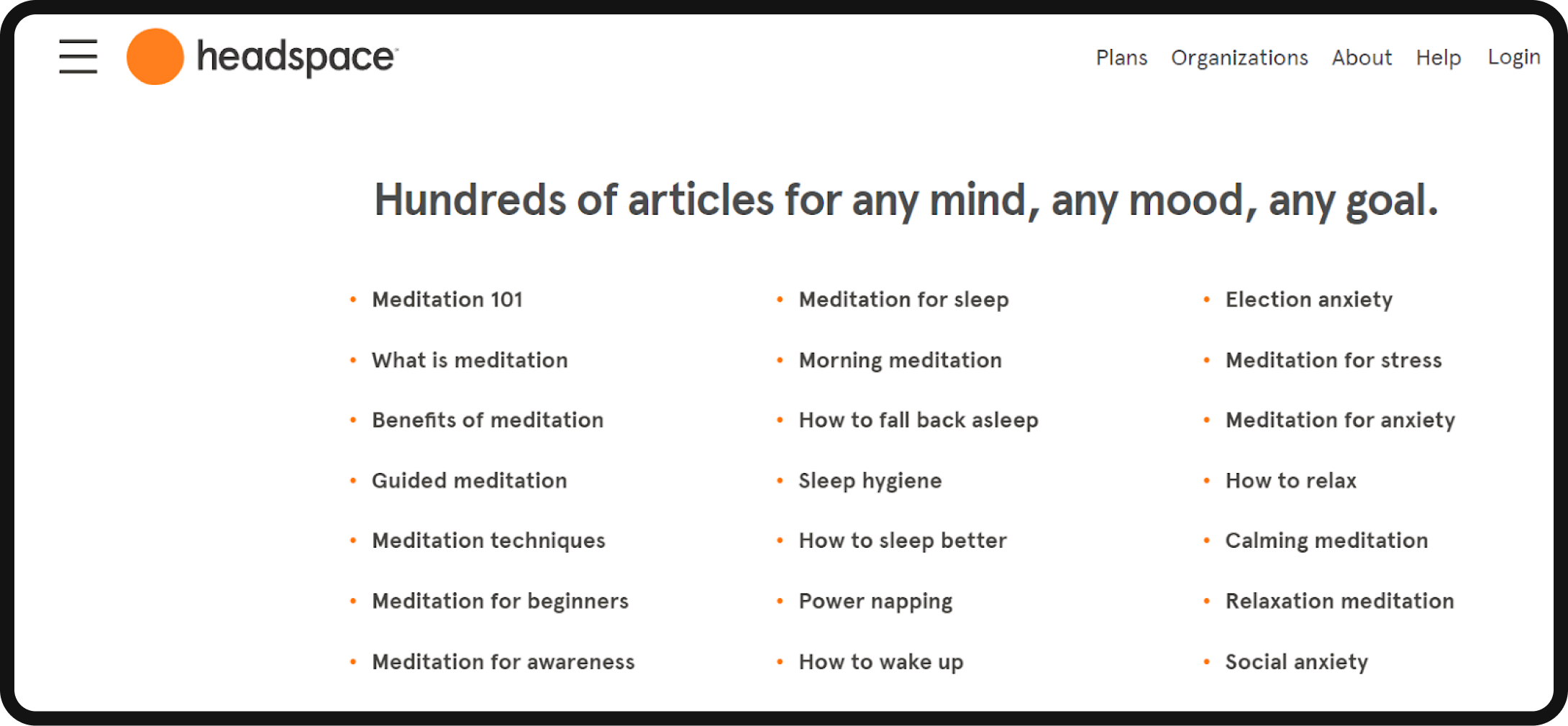
To follow Headspace’s lead:
- Stay attuned to current events and cultural trends that may impact stress levels.
- Develop content that offers practical solutions and techniques for stress management.
- Leverage social media platforms to share bite-sized stress-relief tips and engage with your audience.
- Experiment with different creative formats and social media platforms and see what works best for your audience.
- Collaborate with mental health experts or influencers to provide credible insights and advice.
- Monitor the performance of your stress-related content and adjust your strategy based on user feedback and engagement metrics.
By drawing inspiration from successful brands like Headspace, you can tailor your content to resonate with your target audience and address their specific needs and concerns related to stress.
Furthermore, you can always draw inspiration from healthcare content creators for specific social media channels, like TikTok. This information will serve as a valuable guide for refining your content plan based on what’s proven to be effective within your sector. Also, this will help you establish which types of content to steer clear of, as healthcare content marketing should always be sensitive to the patients.
Strategy 4: Implementing your content marketing strategy
Implementing your content marketing strategy involves several critical steps to ensure its success. Let’s break down these steps and discuss their significance in more detail:
Collaborate with healthcare experts
After carefully choosing and delving into your healthcare content topics, it’s imperative to integrate medical proficiency into your content creation process. There are two effective approaches to accomplish this:
- Engage with medical experts from the initial content creation phase, involving them directly in the writing and content development process.
- Alternatively, you can opt to enlist marketers with a background in the medical field to craft the initial drafts of your content. Subsequently, you can streamline the process by having subject matter experts review and validate the content.
The latter approach is often the more streamlined and efficient option, as it requires less time and involvement from your experts while ensuring that the content maintains the required level of medical expertise and compliance.
Strategic content planning
Before diving into content creation, it’s crucial to strategize effectively. Begin by plotting a macro view of your healthcare business milestones, product launches, and seasonal events. By doing so, you can align your content marketing priorities with these significant initiatives while remaining flexible in responding to sudden media events or trending topics. This step ensures that your content efforts are closely aligned with your overarching business objectives, providing a clear roadmap for your content strategy.
Streamlined content creation process
Creating a structured content creation process is the backbone of a successful content marketing strategy. Regardless of your team’s size, this process helps align roles and responsibilities, fostering a sense of ownership and accountability among team members. Implementing creative briefs during the pre-production stage helps define deliverables and approval processes.
Editorial calendar management
To maintain a steady publishing cadence, an organized editorial calendar is indispensable. It serves as your content roadmap, ensuring consistency in messaging and engagement with your healthcare audience. Plan your publishing schedule at least one quarter in advance, in line with your content creation process. Moreover, allocating time for brainstorming sessions enables the generation of fresh and engaging content ideas, making your content marketing efforts more effective.
Leveraging content repurposing
Content marketing success isn’t solely about producing copious amounts of content. It’s about creating valuable content consistently and maximizing its utility. Repurposing content is a powerful strategy. For instance, consider transcribing or summarizing podcasts into articles or blog posts. Key findings from reports or surveys can be repackaged into compelling infographics. Additionally, explore localization or translation to reach diverse patient populations. Extend your reach beyond your website by leveraging digital channels, social platforms, and influencers that align with your audience’s preferences.
Gauge impact and value
To ensure your healthcare content marketing strategy aligns with business goals, robust measurement and management are essential. Three fundamental components to assess effectiveness include cost, utilization, and performance. Evaluate the costs associated with producing different types of content to make informed budget decisions. Maximizing content utilization across various channels can significantly enhance ROI. However, focus on measuring engagement metrics over vanity metrics like page views or social shares. Meaningful engagement is a better indicator of your content’s value and its contribution to achieving business objectives.
Wrapping up with things to keep in mind
As we wrap up our exploration of the fundamental principles and strategies of healthcare content marketing, we must keep these four key rules in mind. These rules serve as a compass and a guiding light for successful content marketing endeavors.
- Audience-centric approach: Always begin with your audience in mind. Your content should be finely tuned to resonate with the specific audience or group you aim to engage. Remember, it’s not about what interests you; it’s about what captivates and engages them.
- Humanize your content: Strive to retain the human element in your content. While presenting information authoritatively is important, ensuring that your content is easily understood is equally vital. Embrace people-oriented storytelling or adopt a conversational tone when needed. Remember that your audience relates more to personal experiences than dry technical details.
- Avoid self-promotion: Content marketing is not a platform for self-promotion. Instead, it’s about nurturing relationships over immediate actions. Building trust and credibility requires providing unbiased and informative content. An impartial voice is not only convincing but also reliable.
- Patience and persistence: Understand that content marketing yields results over time. Building an engaged audience takes patience and consistent effort. While traditional advertising may offer more immediate returns, content marketing’s true value lies in its ability to foster long-term connections.
- Sustainability is key: Lastly, begin only with what you can sustain. Consistency is paramount in content marketing. Ensure that your resources align with your efforts. Starting small and gradually scaling up is often a wise approach.
Incorporating these rules and tips into your healthcare content marketing strategy will enhance your brand’s visibility and cultivate enduring relationships with your target audience. Remember that healthcare content marketing is a journey, and adhering to these principles will lead you to sustained success.
If you’re curious to know more about our award-winning healthcare content marketing approach, contact us.





